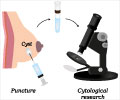Scientists in the U.S have discovered new targets for the treatment of invasive breast cancer.
A new study, led by Suresh Alahari, PhD, Associate Professor of Biochemistry and Molecular Biology Louisiana State University Health Sciences Center New Orleans, has shown for the first time that a tiny piece of RNA appears to play a major role in the development of invasive breast cancer and identified a gene that appears to inhibit invasive breast cancer.The LSUHSC researchers are the first to show that miR-27b, a novel microRNA, not only inactivates the ST14 gene which they found suppresses the growth of breast tumour cells, but also that miR-27b stimulates the breast cancer to invade other cells.
MicroRNAs are a new class of small, single-stranded RNA molecules that play an important regulatory role in cell biology.
They bind to target genes and decrease their function. MicroRNAs may act as oncogenes (a gene that contributes to cancer development) or tumor suppressors.
In this study working with a line of human breast cancer cells, Alahari's team found that aggressively invasive breast tumour cells contain a large quantity of miR-27b molecules, while normal cells do not.
Further analysis revealed that miR-27b increases during cancer progression, in direct proportion to the decrease in function of the ST14 gene.
Advertisement
They also found that ST14 inhibits both cell growth and cell invasion, suggesting that ST14 is a breast cancer tumour suppressor gene and that it may also serve as a marker for the early detection of breast cancer.
Advertisement
The study has been published in the August 21, 2009 issue of the Journal of Biological Chemistry.
Source-ANI
SRM













